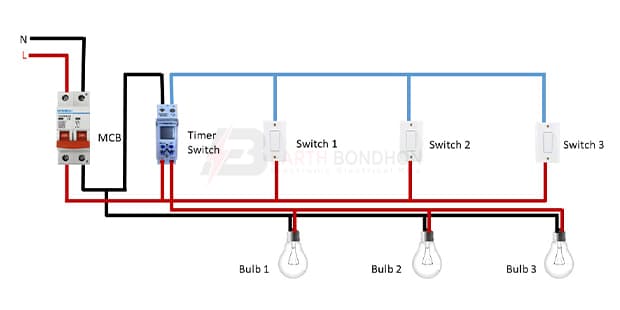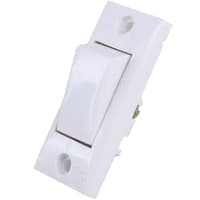Digital Timer connection diagram:
This diagram shows how to make a digital timer connection diagram. In this circuit diagram, we use a DP MCB ( Double Pole Miniature Circuit Breaker ), a digital timer, 3 switches, and 3 lights. First, we need to input power from DP MCB, then from DP MCB to connect power to the Digital timer. After that input switch and timer connection then connect all light connections. Now it’s ready for use. If you want to know more about this circuit please check our youtube video below the post.
Advertisements
Components needed For this Project:
You can get the components from any of the sites below:
- DP MCB 25A [See Buy Click Amazon]
- 8 Pin Timer 220V AC [See Buy Click Amazon]
- SPST Switch [See Buy Click Amazon]
- CFL Light [See Buy Click Amazon]
*Please note: These are affiliate links. I may make a commission if you buy the components through these links. I would appreciate your support in this way!
Advertisements
Components used to make the Digital Timer connection:
DP MCB In 2 Pole MCB, switching & protection is affected in phases and the neutral. A Double Pole or DP Switch is a Switch that Controls 2 Circuits at the same time. In terms of Residential Switching, this Normally means it Switches the live and Neutral at the same time. In Layperson Terms, Double Pole switches or DP Switches are Exclusively Designed to Control 2 Different Electrical Circuits at the same time, which allows the Appliances to Isolate safely and reliably. Fan or light Combinations and Medical Equipment are some of the many applications for DP Electrical Switches and Electrical components.
02. Timer:
A timer is a type of time-switching device that controls and controls Electrical circuits and electrical and electronic devices through time setting (on/off). The timer is basically 8-pin. Like other controlling devices the timer has a coil and when this coil is magnetized, the timer works on/off. The timer has 2 common ends and each common end has normally close and normally open options. When the timer is set by time, the timer trips at the end of that time and turns the common is normally closed (on) to open (off) and normally open (off) to close (on). This is how the timer works.
An SPST (Single Pole Single Throw) Switch is a Switch That only Has a Single Input and can Connect Only to one Output. This means it Only Has one Input Terminal and Only 1 Output Terminal. A Switch is a Mechanical or Controlling Device That Changes the Flow of Current Direction or Interrupts the Flow of Current Within a Circuit diagram. An electrical line using Single Pole Single Throws (SPST) is Perfect for on-off switching. When the SPST is closed, the Circuit is Closed and the light from the lamp switches on the system. When The Single Pole Single Throw (SPST) is then opened, the light from the lamp goes out and the Circuit is off.
04. Light:
CFL stands for Compact Fluorescent Lamp which is an improved version of tube lights of earlier days. Like tube lights, it is a vacuum glass tube with fluorescent powder coating which is not as long and straight as tube lights but curved/twisted compact, or small in size. Like a tube light, it has electrodes or filaments at both ends. But in this case, instead of a choke, there is an electronic circuit that drives the Compact Fluorescent Lamp. Because the red wave is less in the light of the Tubelight and Compact Fluorescent Lamp, the object looks a little pale or the correct color of the object does not appear.
Thank You for visiting the website. Keep visiting for more Updates.
Frequently asked questions
These kinds of timers work by delaying the application of the power supply to an electrical load until a specific time has elapsed. Once the timer has elapsed, the power supply is applied and remains on until the timer expires. At this point, the power supply is removed from the load and remains off until the power supply is reapplied.
Timing circuit Diagrams are used for bit (and sometimes byte) synchronization, whereas control circuit Diagrams are used for the exchange of status information, commands, and responses. Some interfaces employ only one function per interchange circuit Diagrams.
A timing Circuit diagram is the graphical representation of input and output signals as functions of time. Since the inputs and outputs can only take the values 0 or 1, their graphical representations are a series of the power supply square pulses with a variety of time lengths.
A timing Circuit diagram includes timing data for at least one horizontal lifeline, with vertical messages exchanged between states. Timing Circuit diagrams represent timing data for individual classifiers and interactions of classifiers. You can use this Circuit diagram to provide a snapshot of timing data for a particular part of a system.
You begin a timing diagram by creating one or more lifelines and then adding states along each lifeline. When you finish adding states or other elements, place a destruction event at the end of the lifeline. A destruction event indicates the end of the lifeline instance.
Read more Single Phase Wiring
What is a kilowatt-hour (kWh) | kwh formula | What does kwh mean
Introduction to Electrical Units and CircuitskW and kWh on your electricity bill As your home uses electricity during...
What is the Difference Between kVA | What does KVA mean | kVA formula
Difference Between KVA ExplainedWhat does KVA Mean? There are technical terms aplenty when it comes to generators, and...
Power Factor | Power Unit | Energy | Electricity Unit
Power factor definition | Calculating Power FactorPower Factor Values In a purely resistive circuit, the power factor...





0 Comments